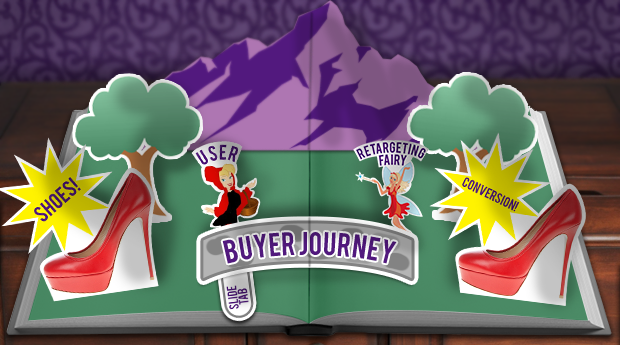Retargeting and the Power of Story

I still remember the first retargeting campaign that I created. It was late 2009, and Nebo was lucky enough to be enrolled in Google’s beta remarketing program.
While the concept of retargeting wasn’t new at that point, Google opened the doors and made it easier to jump in and create retargeting campaigns that reached a large audience regardless of budget.
Those first few retargeting campaigns I created were pure magic, considering I put minimal effort into them. This was not entirely out of laziness; back then, there just wasn’t much you COULD do. Essentially, I would set up two audiences, those that came to a site and converted and those that came to a site and didn’t convert, and then had one ad for each of those audiences. Then I watched the ROI on these campaigns hit up to 10x the return of the general display campaigns.
The whole thing was too good to be true—literally. As time passed and Google opened up their platform to everyone, the performance of these campaigns started to decline. The return was still better than any general display or search campaign, but the “crazy awesome” metrics dwindled to just “pretty awesome.”
It was easy to see why. The floodgates had opened, most advertisers were approaching retargeting in the same way, and people were sick of seeing the same boring, thoughtless ads (mine included) follow them everywhere they went online.
It was around then that I realized that approaching retargeting as just another tool to get your ads in front of your audience was resulting in a huge missed opportunity.
What's Your Story?
We all know that retargeting has crazy potential (a staggering 98 percent of people don’t convert on a site within their first visit), and now there are tons of tools that make it easy to retarget to people through display, search, email, social networks—you name it.
But it’s not the tools that you use that matter; it’s the approach. Without a strong strategy in place, it’s really easy to squander that opportunity or worse, completely annoy your audience.
Retargeting is marketing, and it should be approached that way. Not as a tactic, not as a tool, but as another way to offer value to your target audience. It’s a way to finish telling a story.
Because of this, before you can have a successful retargeting campaign, you have to establish a strong brand story.
To be clear: story is not a mission statement. Your story should reveal something about your brand that drives some form of emotion in your audience. It can be love, fear, sympathy, pride, anger—anything but apathy. Determining your brand story is hard, but having a compelling story is the difference between a brand that customers absolutely love and one that people despise or worse, don’t even care about. Think about some of the most loved brands in the world, such as Coke or Apple. They aren’t so well loved just because of their product; they work hard to create emotionally engaging brand experiences that reflect their story.
Without a story, you’re just more noise in an already crowded marketplace.
Telling Your Story
Creating an engaging story is arguably the most difficult part of a marketing strategy, but researching your target audience is just as important. Particularly in retargeting, knowing not just who your audience is but what they care about, what motivates them, what they are afraid of, and what questions they have can be paramount to your success as these audience feelings should drive your retargeting messaging.
The trap that a lot of marketers fall into is to create audience “personas” that are based off of what a Marketing Manager thinks his or her audience is or should be. Oftentimes, this doesn’t match up with who their audience really is. To truly find out what your audience cares about, you could invest a few million dollars into neuromarketing research; but if you weirdly don’t have that option, we’ve found the best way to approach qualitative research is to combine the usual target audience research with interviews of the people at companies that are closest to the audience: sales people, customer service reps, customer support reps, etc. These people often have a wealth of insight into what the audience actually cares about, what questions they hear the most, and what offers work the best within the audience.
This qualitative research combined with quantitative analysis of what your audience has already seen or interacted with on your site should set you up to determine who your audience is and where they are in their buyer journey, allowing you to finish telling your story by offering the right retargeting message to the right segments.
You may have an audience segment of women who came from a Facebook ad campaign and only saw the homepage; you should know what to show them that engages emotion, offers value, and brings them back into your funnel. You may have a segment of people who have put things in their cart but then left right before purchasing; you should know what message to give them that drives them to make that final decision (and it’s not a generic dynamic ad that just shows them exactly what they have in their cart).
[caption id="attachment_14949" align="alignnone" width="620"] Showing people the same products they just saw on your site again and again everywhere they go on the internet adds no value. Instead, show them something else they might like, offer thought leadership or benefits, or otherwise incent them to come back.[/caption]
Showing people the same products they just saw on your site again and again everywhere they go on the internet adds no value. Instead, show them something else they might like, offer thought leadership or benefits, or otherwise incent them to come back.[/caption]
You have to offer customized value to specific segments to be successful in retargeting. Yes, the internet is messy. There are multi-devices and multi-browsers, and some people just won’t behave like you thought they would. But with so many boring, useless retargeting ads out there, you have a responsibility to respect your audience and to try your damndest to give them something that will make an impact.
Because while there are many approaches to retargeting ad messaging, one thing is sure: nobody wants to see the same thing they just saw on your site, and nobody wants to see the same ad over and over again on every page of the internet.
Retargeting has come a long way in the past 4 years. With better targeting and easier setup, you now have a chance to truly re-engage a lost audience and finish telling your story. Don’t waste it.

Comments
Add A Comment